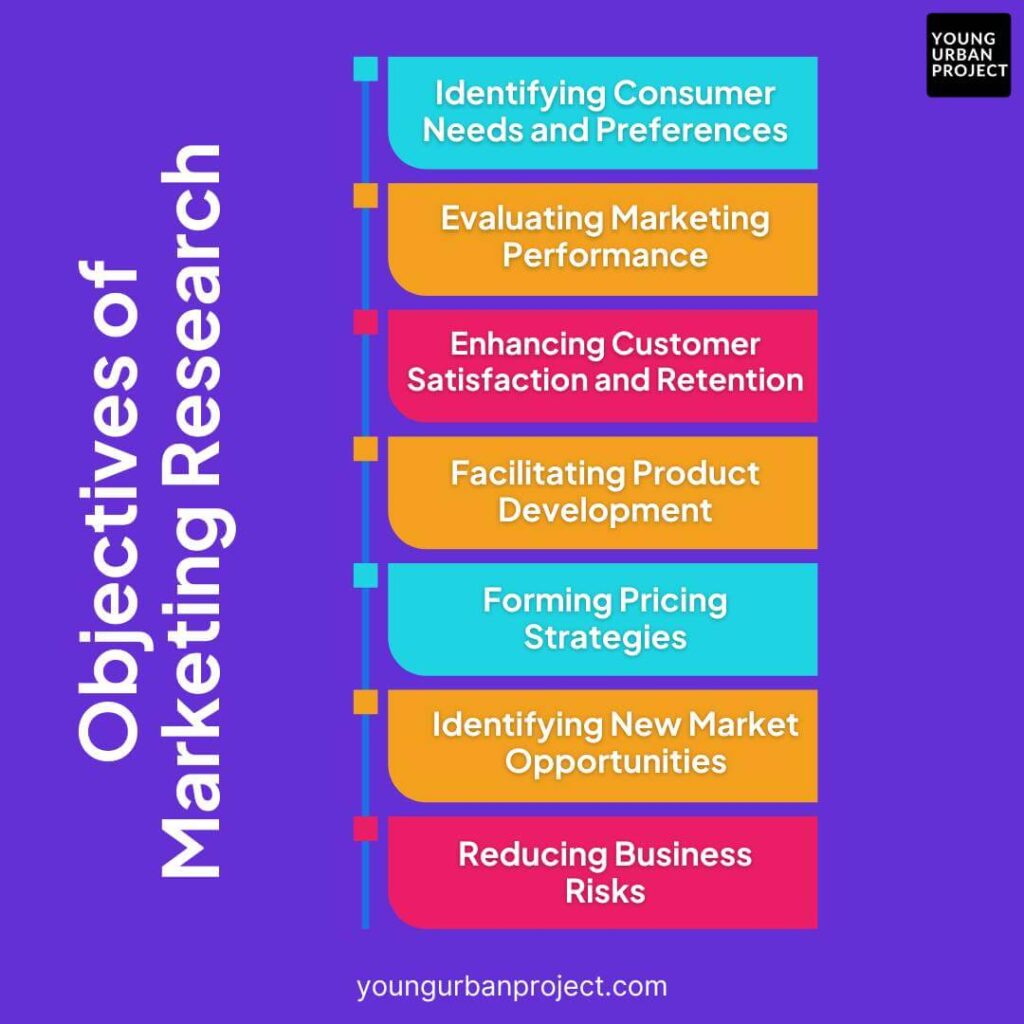Marketing research is a critical function in any business, guiding strategic decisions that can make or break a product or service in the marketplace. Unlike market research, which focuses on understanding the broader market, marketing research focuses on Aspiring Product marketers the specifics of marketing activities. It seeks to understand consumer behaviors, optimize campaigns, and refine strategies to meet business goals.
Table of Contents
Whether you’re a product marketer, a student of marketing, or someone interested in learning about the field, this guide will provide you with an exhaustive understanding of the objectives of marketing research.
Marketing research is not just about gathering data; it’s about using that data to achieve specific marketing goals. The objectives of marketing research are multifaceted, aiming to inform decisions, reduce risks, and uncover opportunities.
Below, let us look at the key marketing research objectives.

1. Identifying Consumer Needs and Preferences
One of the primary objectives of marketing research is to understand what consumers want and need. By identifying these needs, companies can develop products and services that truly resonate with their target audience.
Example
Apple’s approach to product development is considered to be iconic and serves as a benchmark for companies across the world. Through extensive marketing research, Apple (originally a personal computer company, and later an portable audio player company) identified a growing consumer demand for a smartphone that combines powerful computing capabilities with a user-friendly interface. The insights gained from this research led to the creation of the iPhone, a product that revolutionized the smartphone industry.
How to Conduct This Research
Marketers often use surveys, focus groups, and in-depth interviews to gather data on consumer needs. Tools like Net Promoter Score (NPS) surveys can help quantify customer satisfaction and identify areas for improvement.
2. Evaluating Marketing Performance
Marketing research is essential for assessing the effectiveness of marketing campaigns. By measuring and evaluating performance, businesses can determine what’s working, what’s not, and where to allocate resources for maximum impact.
Example
Coca-Cola routinely conducts marketing research to assess the performance of its campaigns. For example, after launching its “Share a Coke“ campaign, the company used marketing research to measure the campaign’s impact on sales and brand engagement. The insights revealed that the campaign significantly boosted consumer interaction and sales, leading to its expansion into other markets.
Also Read: Advantages and Disadvantages of Marketing Research
How to Conduct This Research
This can be done through A/B testing, tracking key performance indicators (KPIs), and analyzing consumer behavior data using tools like Google Analytics. Marketing mix modeling (MMM) is another technique that helps determine the effectiveness of different marketing channels.
3. Enhancing Customer Satisfaction and Retention
Customer satisfaction and retention are vital for long-term business success. Marketing research helps businesses understand what drives customer loyalty and how they can improve their offerings to enhance satisfaction.
Example
Amazon is a prime example of a company that uses marketing research to enhance customer satisfaction. By continuously gathering and analyzing customer feedback, Amazon optimizes its services, from faster delivery times to a more personalized shopping experience, leading to high levels of customer retention.
How to Conduct This Research
Conduct customer satisfaction surveys, track customer feedback on social media, and use retention analysis tools to identify patterns in customer behavior. Win/loss interviews can also provide deep insights into why customers stay or leave.
4. Facilitating Product Development
Marketing research is crucial in the product development process. It helps businesses understand market gaps, consumer desires, and the competitive landscape, enabling them to create products that meet specific market needs.
Example
Before launching the Tesla Model S, Tesla conducted extensive marketing research to understand what consumers wanted in an electric vehicle. This research revealed that consumers desired not only an eco-friendly car but also one that offered luxury and performance. Tesla used these insights to design the Model S, which became a game-changer in the automotive industry.
How to Conduct This Research
Use concept testing, prototype testing, and beta testing to gather feedback on new product ideas. Competitive analysis and trend analysis can also provide insights into product development opportunities.
Also Read: What is Customer-centric Product Development
5. Forming Pricing Strategies
Pricing is a critical component of any marketing strategy. Marketing research helps businesses determine the optimal price point for their products or services, balancing profitability with consumer willingness to pay.
Example
Nike uses marketing research to inform its pricing strategies. By analyzing consumer behavior, competitor pricing, and market demand, Nike adjusts its pricing to maintain a competitive edge while maximizing profitability.
How to Conduct This Research
Conduct pricing research through surveys, conjoint analysis, and price sensitivity analysis. Monitoring competitor pricing and market trends is also essential for developing effective pricing strategies.

Checkout: Product Marketing Course
6. Identifying New Market Opportunities
One of the most strategic objectives of marketing research is to uncover new market opportunities. This can involve identifying untapped customer segments, new geographic markets, or potential product expansions.
Example
Starbucks used marketing research to identify an opportunity in the Chinese market. By understanding local tastes and preferences, Starbucks tailored its menu and store experience to fit the Chinese market, leading to its rapid expansion and success in the region. It has also done something similar in India, where they introduced the “South Indian Filter Coffee” as a part of the menu. Check it out below:

How to Conduct This Research
Use market segmentation analysis, geographic market research, and competitive analysis to identify new opportunities. Look for trends in consumer behavior and emerging markets that align with your business goals.
7. Reducing Business Risks
Marketing research helps businesses mitigate risks by providing data-driven insights that inform decision-making. Whether launching a new product or entering a new market, research reduces the uncertainty and increases the chances of success.
Example
Before launching its streaming service, Disney conducted extensive marketing research to understand consumer preferences and behaviors in the streaming industry. This research helped Disney tailor its content offerings and marketing strategy, leading to the successful launch of Disney+.
How to Conduct This Research
Risk can be mitigated through feasibility studies, pilot testing, and scenario analysis. Gathering data on market conditions, consumer behavior, and competitive actions can help reduce the likelihood of costly mistakes.
In the end…
Marketing research is an indispensable tool for businesses aiming to make informed, strategic decisions. Aspiring Product marketers are expected to have some hands-on knowledge in it. Whether it’s identifying consumer needs, evaluating marketing performance, or reducing business risks, the objectives of marketing research provide a roadmap for success. By understanding and applying these objectives, businesses can not only meet but exceed their marketing goals, leading to sustained growth and competitive advantage.

